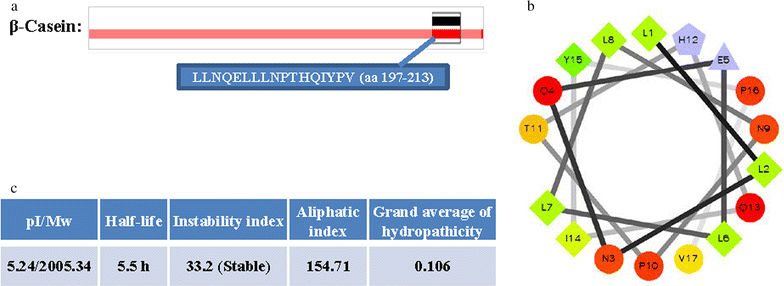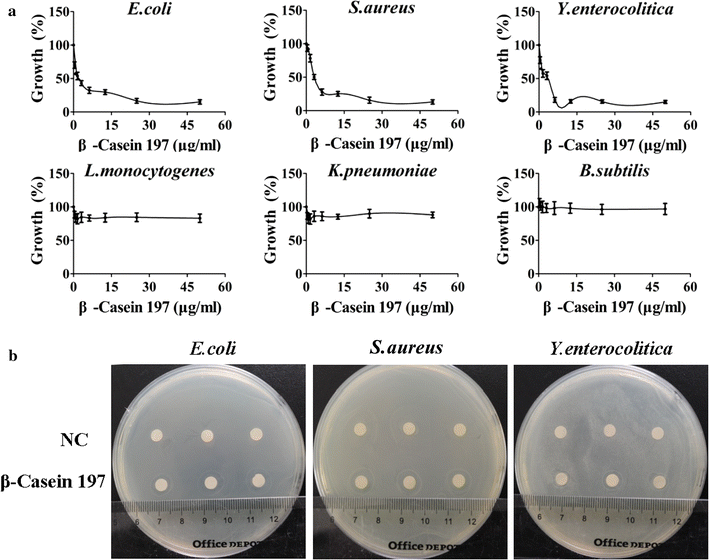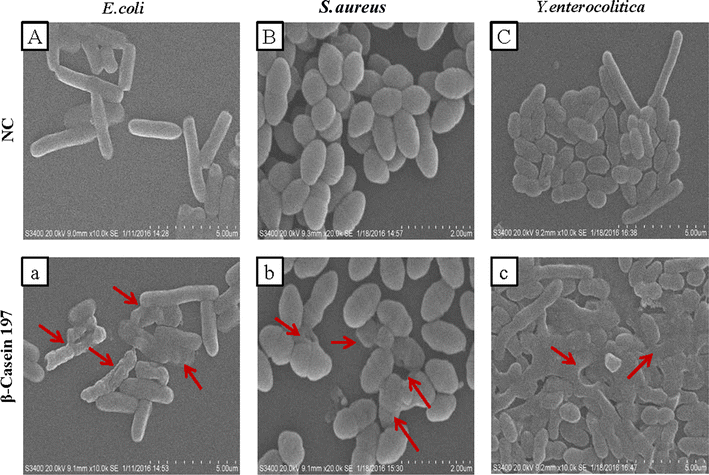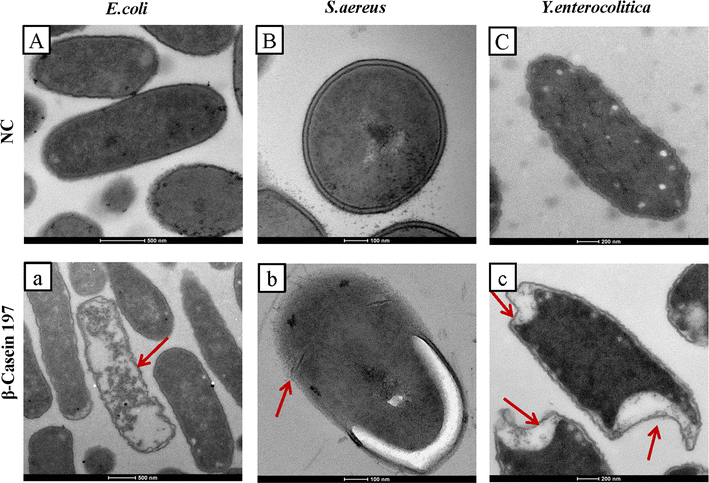Investigation into the antimicrobial action and mechanism of a novel endogenous peptide β-casein 197 from human milk
- PMID: 28591979
- PMCID: PMC5461228
- DOI: 10.1186/s13568-017-0409-y
Investigation into the antimicrobial action and mechanism of a novel endogenous peptide β-casein 197 from human milk
Abstract
A novel endogenous peptide cleaved from 197-213 AA of β-casein, named β-casein 197, was identified by tandem mass spectrometry. β-casein 197 constituted a significant proportion of the peptide content in preterm milk. This study investigated the antibacterial effects and mechanisms against common pathogenic bacteria. Six bacterial strains were selected for this study: Escherichia coli, Staphylococcus aureus, Yersinia enterocolitica, Listeria monocytogenes, Klebsiella pneumonia and Bacillus subtilis. After synthesis, serial twofold dilutions of β-casein 197 were added to select for sensitive bacteria. The disk diffusion method and analysis of bacterial staining were used to identify antibacterial effect, while DNA-binding, scanning electron microscopy and transmission electron microscopy were used to explore antimicrobial mechanisms. Disk diffusion showed that E. coli, S. aureus and Y. enterocolitica were sensitive to the β-casein 197. In addition, live/dead fluorescent staining also confirmed antibacterial effects. Scanning electron and transmission electron microscopy revealed affected extracellular and intracellular structure for three species of bacteria, while a DNA-binding assay showed that the antimicrobial activity did not occur through DNA binding. This study suggests that β-casein 197 has antimicrobial activity against common pathogenic bacteria in newborns with infection. The peptide induced membrane permeabilization but did not bind to genomic DNA. Based on our findings, β-casein 197 has potential clinical value for preventing infections of premature infants.
Keywords: Antibacterial effect; Common pathogenic bacteria; Human milk; β-Casein 197.
Figures






Similar articles
-
Antimicrobial activity and mechanism of PDC213, an endogenous peptide from human milk.Biochem Biophys Res Commun. 2017 Feb 26;484(1):132-137. doi: 10.1016/j.bbrc.2017.01.059. Epub 2017 Jan 16. Biochem Biophys Res Commun. 2017. PMID: 28093229
-
A novel endogenous antimicrobial peptide CAMP211-225 derived from casein in human milk.Food Funct. 2020 Mar 26;11(3):2291-2298. doi: 10.1039/c9fo02813g. Food Funct. 2020. PMID: 32104859
-
Antimicrobial activity and mechanism of the human milk-sourced peptide Casein201.Biochem Biophys Res Commun. 2017 Apr 8;485(3):698-704. doi: 10.1016/j.bbrc.2017.02.108. Epub 2017 Feb 27. Biochem Biophys Res Commun. 2017. PMID: 28242197
-
Antimicrobial activity, environmental sensitivity, mechanism of action, and food application of αs165-181 peptide.Int J Food Microbiol. 2021 Nov 16;358:109403. doi: 10.1016/j.ijfoodmicro.2021.109403. Epub 2021 Sep 11. Int J Food Microbiol. 2021. PMID: 34543802
-
Antibacterial activity of casein-derived peptides isolated from rabbit (Oryctolagus cuniculus) milk.J Dairy Res. 2003 May;70(2):189-97. doi: 10.1017/s0022029903006150. J Dairy Res. 2003. PMID: 12800873
Cited by
-
Which is the optimal choice for neonates' formula or breast milk?Nat Prod Bioprospect. 2024 Mar 15;14(1):21. doi: 10.1007/s13659-024-00444-0. Nat Prod Bioprospect. 2024. PMID: 38488905 Free PMC article.
-
HMP-S7 Is a Novel Anti-Leukemic Peptide Discovered from Human Milk.Biomedicines. 2021 Aug 9;9(8):981. doi: 10.3390/biomedicines9080981. Biomedicines. 2021. PMID: 34440185 Free PMC article.
-
Peptidome analysis of umbilical cord mesenchymal stem cell (hUC-MSC) conditioned medium from preterm and term infants.Stem Cell Res Ther. 2020 Sep 23;11(1):414. doi: 10.1186/s13287-020-01931-0. Stem Cell Res Ther. 2020. PMID: 32967723 Free PMC article.
References
-
- Dallas DC, Smink CJ, Robinson RC, Tian T, Guerrero A, Parker EA, Smilowitz JT, Hettinga KA, Underwood MA, Lebrilla CB, German JB, Barile D. Endogenous human milk peptide release is greater after preterm birth than term birth. J Nutr. 2015;145:425–433. doi: 10.3945/jn.114.203646. - DOI - PMC - PubMed
LinkOut - more resources
Full Text Sources
Other Literature Sources

